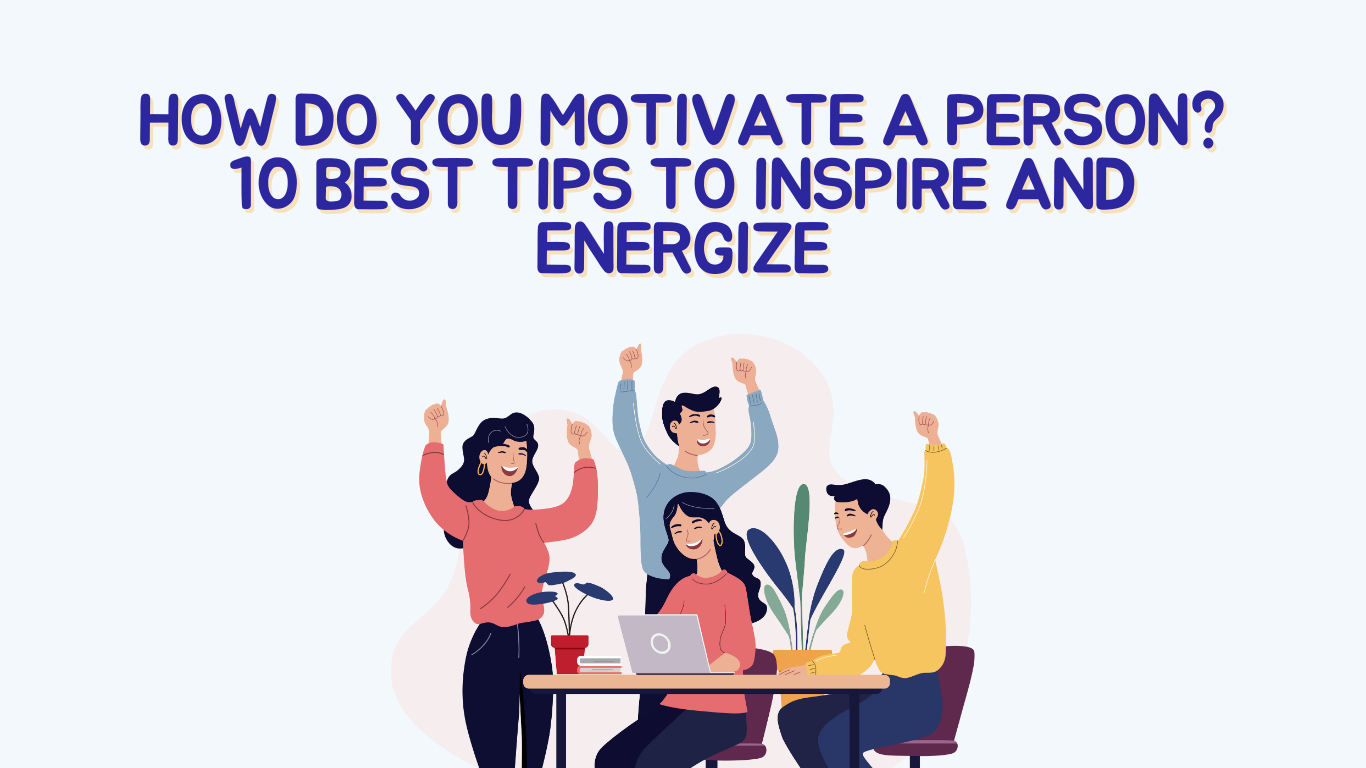Whether it’s in the workplace, at home, or elsewhere, finding effective ways to motivate and inspire someone can be challenging. This article provides actionable tips to help you understand and motivate anyone in your life.

Key Takeaways
- Understand what motivates individuals by recognizing intrinsic versus extrinsic drivers, enabling a tailored approach to inspire them.
- Set clear, achievable goals and break them down into smaller tasks to enhance focus and maintain motivation.
- Foster a supportive environment that provides feedback, positive reinforcement, and promotes autonomy to enhance engagement and commitment.

Understand Their Motivations
Great leaders know that the first step in motivating others is gaining a deep understanding of what drives them. Human beings are complex, and what motivates one person may not necessarily inspire another.
Asking questions and listening attentively reveals the core motivations of those you seek to inspire. Having one-on-one meetings or casual conversations can help reveal a person’s motivation, which are critical for sustained motivation.
Recognizing that everyone is motivated differently allows you to tailor your motivational strategy effectively. It’s about identifying what drives them and recognizing the quieter, more subtle efforts involved in motivation.
Environmental conditions and the quality of relationships also play a significant role in supporting or hindering motivational states.
Identify Intrinsic and Extrinsic Motivators
Intrinsic motivation comes from within and is driven by internal desires, such as personal satisfaction and fulfillment. This type of motivation often leads to deeper engagement and long-term commitment.
On the other hand, extrinsic motivation is fueled by external rewards like praise, money, or recognition. While these rewards can be effective, they often result in short-term compliance rather than sustained motivation.
Grasping the difference between intrinsic and extrinsic motivators is essential. Intrinsic motivation tends to be more powerful and long-lasting, making it a key focus for those aiming to inspire and energize others. Identifying the best motivators for each individual allows you to craft a more effective strategy.
Personalize Your Approach
Tailoring motivational strategies to individual preferences can significantly enhance their effectiveness. Everyone has unique values, interests, and goals that drive them. Understanding these personal factors allows you to better engage and motivate individuals.
For example, someone who values personal growth might feel motivated by opportunities for self-improvement, whereas another person might be driven by achieving success in specific tasks.
A personalized approach to motivation leads to higher levels of engagement and commitment. It shows that you care about the individual’s specific needs and aspirations, which can make them feel valued and understood. This level of personalization is key to inspiring and energizing those around you.

Set Clear and Achievable Goals
Setting achievable goals with clear expectations is a fundamental way to motivate people. Clear goals provide a sense of direction and purpose, making it easier to stay positive and focused on the task at hand.
The most successful leaders are able to communicate their vision effectively. If everyone can see the big picture, and understands their own role and expectations, it creates synergy.
Following up on their progress with regular check-ins adds accountability and encourages continuous effort. This structured approach to goal achievement can boost overall motivation.
Break Down Tasks
Dividing larger objectives into smaller tasks helps manage the workload and keeps people focused and motivated. When tasks are broken down, they become less intimidating and more manageable, making it easier to maintain momentum and achieve success. Celebrating small victories along the way can further reinforce motivation and provide a sense of accomplishment.
Focusing on one small task at a time allows individuals to better utilize their skills and feel a sense of progress with each step. This approach not only reduces feelings of intimidation but also keeps motivation high by regularly acknowledging and celebrating achievements.
Use SMART Criteria
Using the SMART criteria—Specific, Measurable, Achievable, Relevant, and Time-bound—ensures that each goal is well-defined and attainable. This method helps in setting clear goals that are easier to track and achieve. Specific and measurable goals lead to improved commitment and focus, while time-bound goals encourage timely action and prevent procrastination.
Applying the SMART criteria helps create daily goals that improve focus, reduce anxiety, and increase motivation. This structured approach to goal setting provides a clear roadmap for achieving success and maintaining motivation.

Provide Positive Reinforcement
Positive reinforcement is a powerful tool for motivating people. Regularly acknowledging efforts and achievements can significantly boost morale and encourage continued effort. Recognition and praise enhance feelings of being valued, leading to increased loyalty and productivity.
Positive feedback fosters positive feelings, making individuals feel rewarded and energized. This approach is essential for maintaining motivation and ensuring that people feel valued and appreciated for their hard work.
Praise and Compliments
Praise and compliments can make people feel cared for and energized. Celebrating incremental achievements keeps motivation high and commitment to goals strong.
Showcasing achievements regularly can invigorate motivation and drive further success. This consistent positive reinforcement helps individuals feel valued and appreciated, enhancing their overall motivation and performance.
Reward Systems
Effective reward systems align with individual values and motivations, promoting engagement without fostering unhealthy competition. The right incentives, when executed properly, can significantly boost motivation and create a collaborative atmosphere.
A well-implemented incentive system reinforces motivation and teamwork by creating a motivating environment that encourages individuals to strive for their best. This approach helps in maintaining a positive and supportive environment where everyone feels valued and inspired to succeed.

Foster a Supportive Environment
Creating a supportive environment is crucial for motivating people. By engaging in conversations and providing support, leaders can make others feel valued and important. A safe space for open discussions fosters team building and encourages the sharing of different perspectives.
Supporting people in making their own choices fosters a sense of ownership over their work, leading to innovative solutions and increased ambition. Consistency in check-ins allows for timely adjustments to goals and helps in addressing any concerns promptly.
Build Strong Relationships
Building strong relationships leads to increased collaboration, trust, and overall satisfaction. Public recognition can be more effective for some individuals, while others may prefer private acknowledgment. Understanding these preferences helps in personalizing the approach and fostering strong relationships.
Strong relationships are the foundation of a supportive environment. They lead to better teamwork, higher morale, and a sense of belonging, all of which are critical for achieving success and maintaining motivation.
Provide Resources
Providing necessary resources is essential for exceptional work and motivation. If there is uncertainty about what the person needs, it is important to ask them directly. Showing care and providing the right resources encourage individuals to provide their best work.
When people have the tools and support they need, they feel empowered and motivated to achieve their goals. This approach fosters a supportive environment where everyone feels valued and encouraged to do their best.

Encourage Autonomy and Ownership
Empowering individuals by allowing them to make decisions increases their intrinsic motivation and engagement. Providing autonomy fosters a sense of ownership, which is essential for lasting motivation.
When individuals have the freedom to work in a way that suits their personal style, they are more likely to stay motivated and committed to their goals.
Delegate Responsibility
An easy way to motivate someone is to believe in their potential. Delegating responsibility shows trust and confidence in their abilities, which can significantly enhance their motivation.
Giving people opportunities to take on more responsibility empowers them to take ownership of their work and feel more engaged and motivated. This approach fosters a sense of pride and commitment to their tasks.
Encourage Initiative
Supporting self-directed efforts allows people to draw from their intrinsic motivations and feel empowered in their work. Encouraging individuals to explore multiple solutions to challenges can enhance their creative problem-solving abilities.
This approach not only encourages initiative but also promotes continuous learning and personal growth.

Reframe Challenges Positively
Viewing challenges as learning opportunities can enhance problem-solving abilities. Challenges should be seen as chances to foster new skills, resilience, and adaptability.
Using narratives of people who overcame obstacles in the world through hard work can effectively inspire and motivate others. Presenting examples of triumph through hard work and dedication serves as a compelling source of inspiration for those lacking motivation.
Focus on Solutions
Focusing on solutions rather than problems helps maintain a positive atmosphere. By directing attention towards finding solutions, individuals can reappraise and reframe challenging situations. This approach encourages a positive mindset and proactive problem-solving.
Leaders who emphasize solution-oriented thinking help their teams or employees stay positive and focused on their goals. This mindset shift not only fosters motivation but also enhances the ability to overcome obstacles and achieve desired outcomes.

Provide Regular Feedback
Regular feedback is crucial for motivation as it helps individuals understand what to improve and track their progress. Feedback can leave people feeling motivated and positive, which enhances overall performance.
Building trust is essential for giving constructive feedback. When employees or team members view critique as an opportunity for improvement rather than a personal attack, they are more likely to feel valued and motivated. As individuals develop, feedback should shift from specific task guidance to coaching problem-solving.
Schedule Regular Check-Ins
Regular check-ins and feedback sessions are more effective than annual reviews. Engaging team members regularly to check progress on their goals helps maintain motivation and ensures continuous improvement.
By scheduling regular check-ins, you can address any concerns promptly and make timely adjustments to goals. This consistent engagement fosters a supportive environment and keeps individuals motivated and focused on their objectives.

Manage Stress Levels
Managing stress levels is essential to prevent burnout and maintain performance. Stress can vary in intensity, and finding the right balance is crucial for sustained motivation.
Coping strategies depend on the intensity and controllability of the stressor.
Promote Work-Life Balance
Encouraging practices that balance work demands with a person’s life can significantly reduce the risk of burnout.
Providing access to tools and techniques for managing stress effectively can improve overall well-being. Implementing stress management techniques helps individuals stay positive and motivated, enhancing their performance and job satisfaction.
Provide Stress Management Resources
Providing stress management resources such as mindfulness and relaxation techniques can significantly reduce stress and improve mental well-being. Time management strategies, such as prioritizing tasks and taking regular breaks, help minimize stress levels.
Learning to decline additional responsibilities is important for managing stress and preserving personal energy. Offering these resources helps individuals manage stress and maintain their motivation.

Cultivate a Growth Mindset
Believing in the potential for growth encourages individuals to embrace challenges and learn from failures. Highlighting effort over innate ability fosters a culture of persistence and continuous self-improvement.
Adopting a growth mindset enhances resilience and encourages individuals to see challenges as opportunities for learning. This mindset shift is crucial for maintaining motivation and achieving long-term success.
Share Success Stories
Sharing success stories can have a powerful motivational effect on individuals. Hearing about others’ achievements through perseverance can significantly boost motivation levels. These narratives serve as compelling sources of inspiration for those lacking motivation.
Success stories highlight the potential for growth and the rewards of hard work, encouraging individuals to stay positive and motivated. Sharing these stories inspires others to pursue their goals with determination and resilience.

Sustain Motivation Through Rituals
Establishing positive rituals can uplift motivation levels and cultivate a consistent approach to goal achievement. Rituals help create new neural pathways that make behaviors easier over time, reinforcing motivation.
Encouraging a solution-oriented mindset can significantly enhance an individual’s motivation. Focusing on solutions rather than problems promotes a proactive mindset and increases motivation.
Create Daily Habits
Establishing consistent daily practices can significantly support the achievement of long-term goals. Incorporating a morning routine helps set a positive tone for the day and boosts motivation. Creating daily habits provides a structure that fosters ongoing motivation.
This approach helps individuals stay focused and committed to their goals, enhancing their chances of success.
Use Reminders and Visual Aids
Regular reminders are crucial for maintaining motivation and ensuring goals are consistently prioritized. External cues, such as sticky notes or vision boards, serve as reminders of commitments and keep personal goals top of mind.
Utilizing these visual aids helps reinforce commitment and keep individuals focused on their aspirations. This approach enhances the likelihood of achieving goals and maintaining motivation.

Summary
In summary, understanding what drives individuals and tailoring motivational strategies to their unique needs is key to inspiring and energizing them. Setting clear and achievable goals, providing positive reinforcement, fostering a supportive environment, and encouraging autonomy and ownership are all essential components of effective motivation.
By reframing challenges positively, providing regular feedback, managing stress levels, cultivating a growth mindset, and sustaining motivation through rituals, you can create a motivating environment that promotes continuous improvement and personal growth. Remember, the key to motivating others lies in understanding their motivations and providing the support they need to achieve their goals.

Frequently Asked Questions
What are intrinsic and extrinsic motivators?
Intrinsic motivators come from within, like personal satisfaction, while extrinsic motivators are shaped by outside rewards, such as praise and money. Understanding this helps you tap into what truly drives you or others.
Why is regular feedback important for motivation?
Regular feedback is crucial because it helps you identify areas for improvement while also tracking your progress, which boosts your motivation and keeps your spirits high.
How can I manage stress levels to maintain motivation?
To manage stress levels and stay motivated, try incorporating mindfulness and relaxation techniques into your routine, along with effective time management strategies. These practices can help you stay focused and reduce overwhelm.
What is the importance of cultivating a growth mindset?
Cultivating a growth mindset is crucial because it helps you embrace challenges and learn from failures, boosting your motivation and resilience. It empowers you to continually grow and improve.

